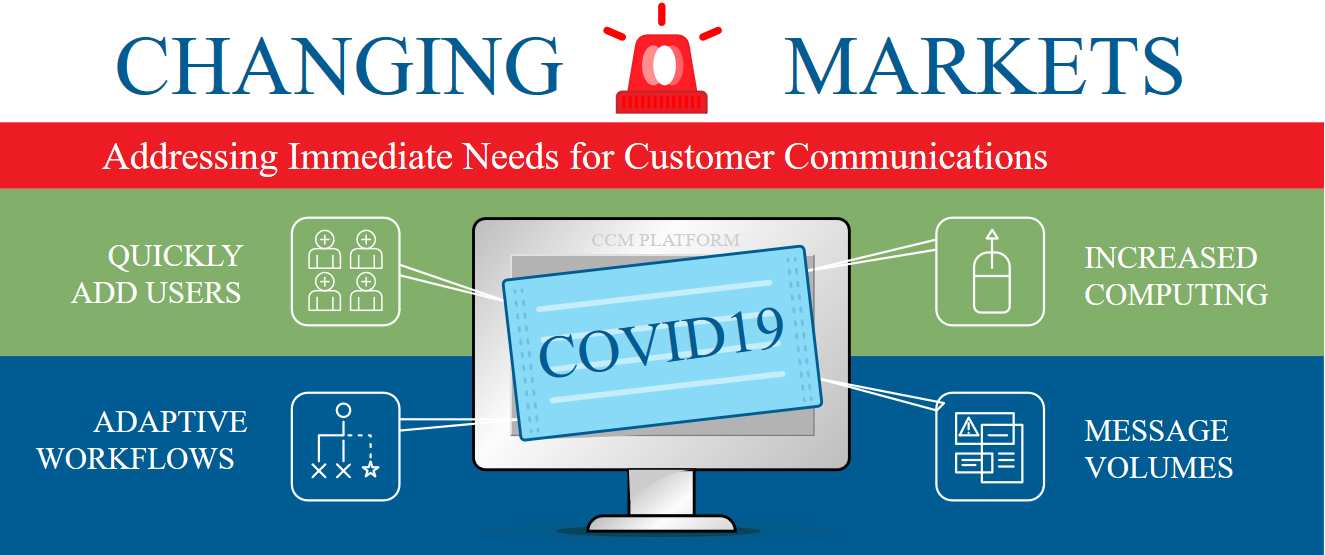
Why Is A Scalable CCM Platform Important?
What happens to customer communications when a business faces a crisis? Well we should all know because Covid-19 just taught us this lesson. What happens to CCM during a crisis goes something like this:
- Customer communications become critical
- Many more people want to engage in crafting and approving messages
- There’s a desire to communicate across all channels (make sure customer sees it)
- The volume of messages spikes
What happens to your CCM platform when all this occurs? You need to quickly add users, adapt workflows, and demand for computing and output resources skyrockets. This is just one instance where having a scalable platform to meet demand matters.
Is this a one-time crisis thing or does volume fluctuate more frequently?
Many companies have seasonal demand. Take for example, the health insurance industry. Most companies do annual healthcare enrollment in the fall. This creates a massive communications peak for health insurers. Financial services has a similar communications challenge at tax time or when the market wildly fluctuates as it did when the Covid-19 crisis hit.

Some peaks are predictable (enrollment periods and tax time), while others are not (virus outbreak). Do you build your communications infrastructure to meet these demand spikes or do you build it for the rest of the year? If you build it for the average volume, how do you handle the peaks?
It would be great if customer communications volume was consistent throughout the year. The reality is it isn’t, for many different reasons. A scalable Customer Communications Management (CCM) infrastructure isn’t just important, in most cases it is necessary.
Benefits of a Scalable CCM Platform
A scalable CCM platform has many advantages, which is why most NextGen CCM platforms have moved in this direction. Here’s a quick look at the scalability benefits of NextGen CCM.
Elasticity – Respond Faster to Macro Market Changes
We started this article discussing how communications volumes fluctuate. Many industries see wild peaks and valleys, which puts a significant strain on legacy platforms. Next-Gen CCM Platforms are scalable or elastic – expanding and contracting as needed.
It’s important to note not all market changes call for scaling the infrastructure up. In some instances, you’ll need to rapidly scale down. This usually occurs when there is a downturn in the business. This might be caused by an external force like the virus or be due to a product failure or recall.
The point is that NextGen CCM Platforms can expand and contract as the business requires and customers only pay for what they are consuming.
Reduce Capital & Operating Expenses
The first, and most obvious benefit, of being scalable is cost. Most NextGen CCM platforms achieve scalability by being cloud based. The cloud provides scalability and eliminates upfront large capital expenditures on computing equipment. With a cloud platform you can pay for the computing and storage you consume, as you consume it.
There is also a human savings with the cloud. Those IT resources that maintain data centers, install operating system patches and trouble shoot issues, are no longer required. With the cloud you share those resources with many other customers and the cost gets bundled into the consumption fee.
Future Proofing
Another hidden benefit is future proofing. Computing equipment, especially data center servers, typically has a life span of three to five years. Every three to five years you’ll need to do another capital outlay, install and migrate all applications. This is time consuming, disruptive and costly. This burden shifts to the CCM provider with NextGen platforms.
It isn’t just the hardware that needs to be future proof. Underlying operating systems are also constantly changing. Security and other patches are issued on almost a daily basis. This requires staff to keep these systems up to date. This burden also shifts to the CCM platform provider.
Security
Along with the servers and operating systems goes a good portion of the effort to secure the platform. Keeping security patches up to date, monitoring the platform and adapting to the threat landscape, detecting and containing attacks, and orchestrating incident response all shifts to the platform vendor with NextGen CCM.
Failover & Disaster Recovery
What happens when the system goes down, for example when a server or hard drive fails? Who’s responsible for maintaining continuity? Who manages the backup and restoration? What are the procedures?
The NextGen CCM Platform provider takes on these burdens. From providing failover to recovering data the burden is shifted from the customer with legacy CCM to the provider with NextGen CCM. This eases the compliance burden and enables IT and line of business managers to sleep better at night.
Having a scalable CCM platform has many benefits that impact cost, security and compliance. Learn more about the benefits of NextGen CCM Platforms in our new eBook.